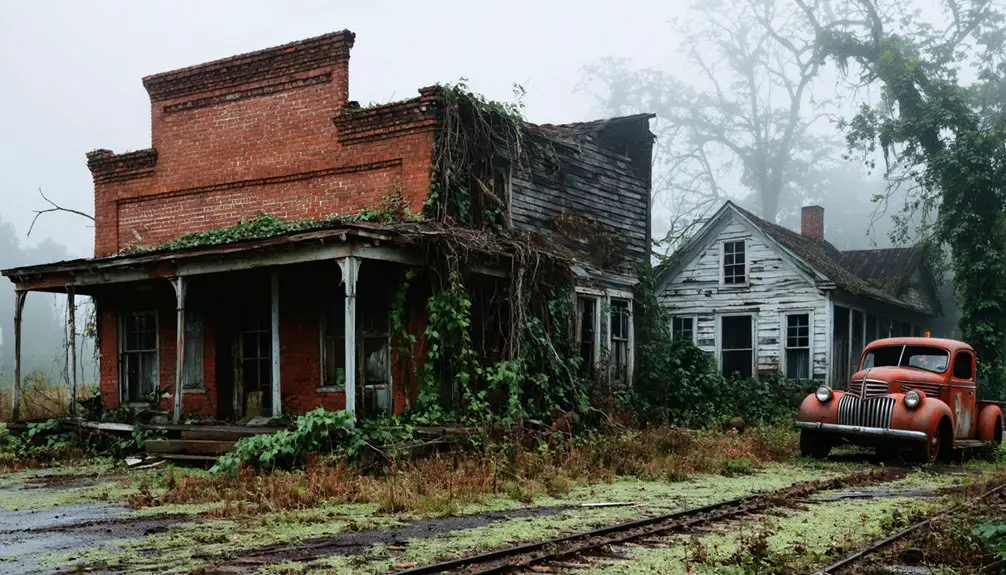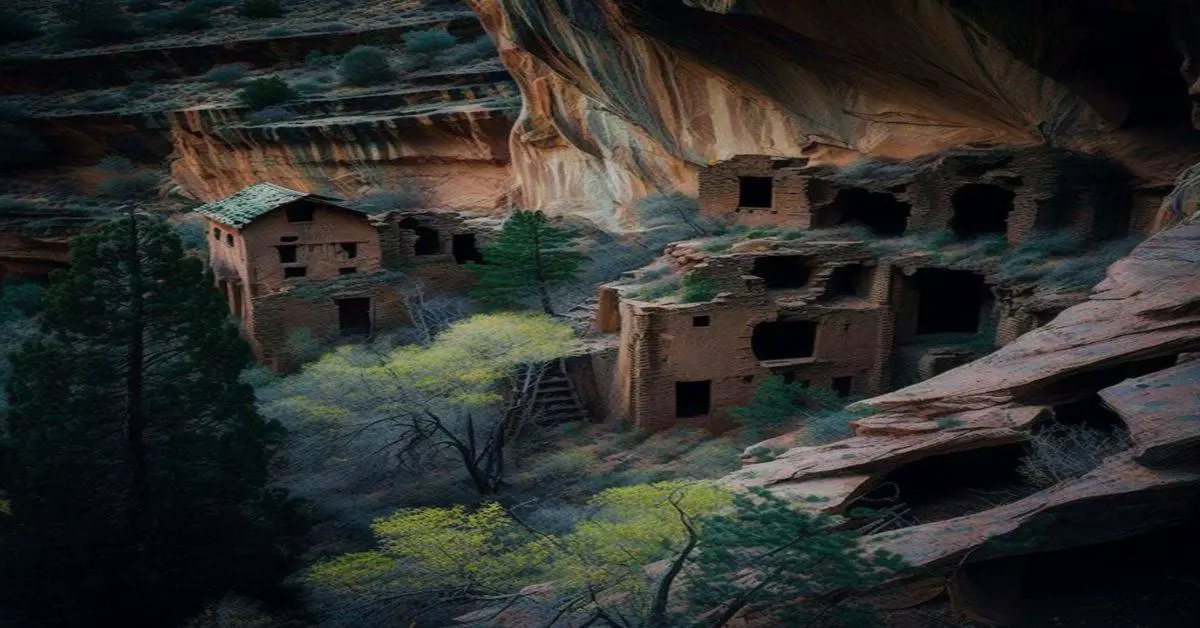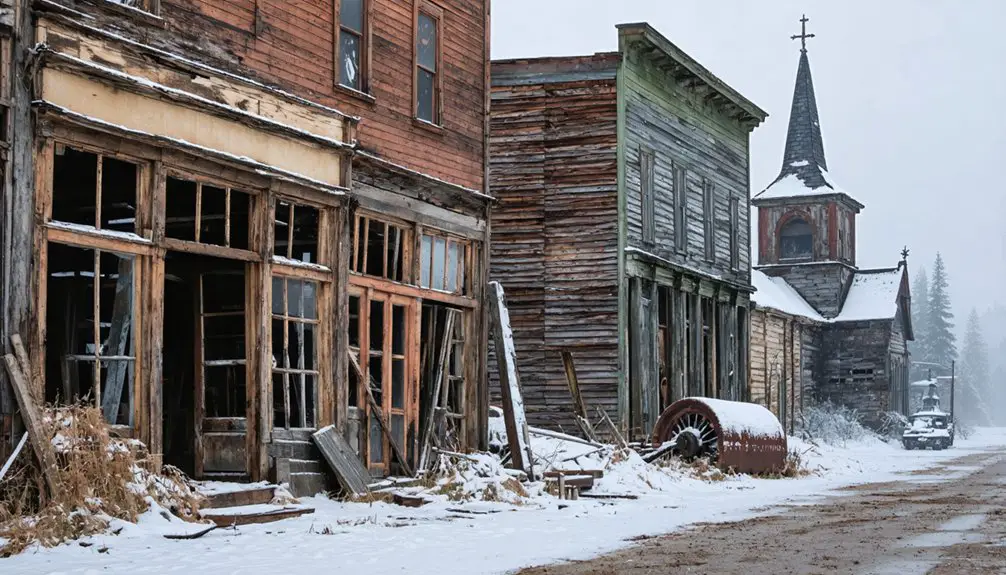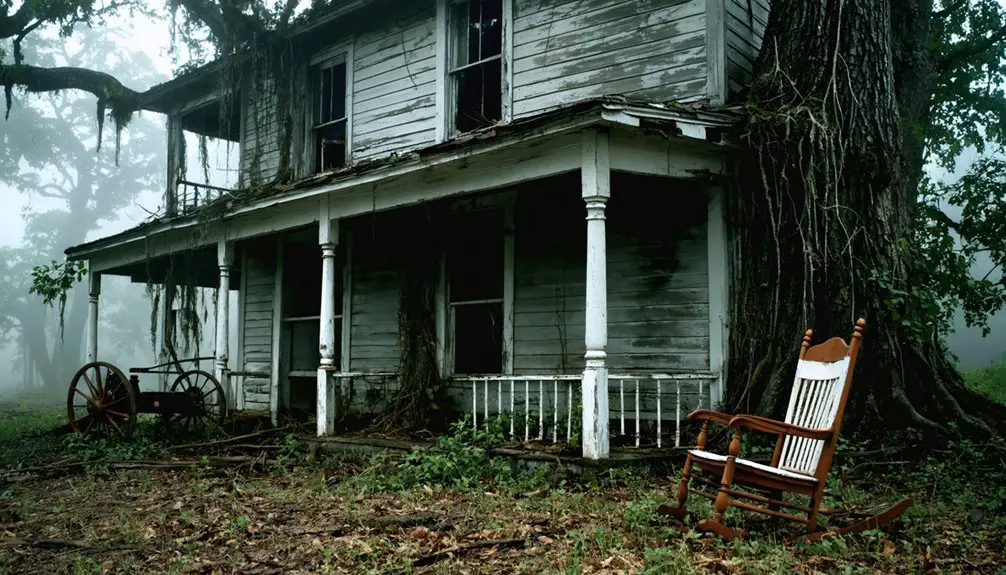You’ll find virtually no trace of Jerryville, West Virginia today, though it once thrived as a bustling coal mining company town. Established after coal’s 1742 discovery, the community featured company housing, an elementary school, and a church by the 1950s. Economic decline struck in the 1980s when mining sector earnings dropped 25%, leading to abandonment. Nature has since reclaimed the landscape, but Jerryville’s story holds crucial lessons about Appalachian mining culture.
Key Takeaways
- Jerryville began as a coal mining camp in West Virginia but is now completely abandoned with no remaining intact structures.
- The town experienced severe economic decline in the 1980s when mining sector earnings dropped 25%, triggering mass population exodus.
- Natural reclamation has overtaken the former townsite, with vegetation covering old buildings, roads, and mining operations.
- Railroad tracks were removed by the late 1970s, and all mine entrances have been sealed or collapsed.
- The ghost town represents a typical example of abandoned coal camp culture in Appalachian mining history.
The Rise of a Coal Mining Community
While coal’s presence in West Virginia had been known since John Peter Salley’s 1742 discovery, Jerryville emerged as one of many coal mining camps that dotted the state’s landscape during the industry’s expansion.
You’ll find that community growth in Jerryville was distinctly shaped by its mining operations, with housing units arriving on flat railroad cars and being positioned near the mining tracks.
Unlike established towns, this settlement started as a basic workers’ camp with minimal infrastructure – just an elementary school and a church by the 1950s.
The houses were particularly compact, often no larger than boxcars and split between families. Life wasn’t easy, as residents had to haul water over long distances and cope with primitive sanitation systems typical of mining camps. The closest town of Webster Springs was fifteen miles away, making transportation and access to supplies particularly challenging.
The miners relied on a massive stone store built in the 1920s that provided everything from groceries to furniture for the local community.
Life in a Company Town
Life in Jerryville exemplified the rigid control mining companies held over their workers’ daily existence. You’d find yourself living in company-owned housing near the mine, shopping at their overpriced store, and often paying with company scrip instead of real currency.
The community dynamics revolved around resource scarcity – families managed without refrigeration, relying heavily on preserved foods and canned milk. The dangerous work underground took its toll on miners’ health and safety daily. Massey Energy’s track record included over 1,300 violations at their mines in the years leading up to 2010.
Your daily life would center around the mine’s schedule, with few recreational options beyond church and school functions. While the community forged strong bonds through shared hardships, you’d face constant economic pressure from inflated store prices and the company’s debt tracking system.
The isolated location and limited amenities meant adapting to basic living conditions, though families found ways to maintain their cultural traditions despite these constraints.
Economic Decline and Abandonment
After decades of coal-driven prosperity, Jerryville’s economic foundation crumbled in the early 1980s when mining sector earnings plunged by 25%.
You’d have witnessed widespread economic hardship as the town’s dependency on coal left it vulnerable to industry decline. Jobs vanished, and with few alternatives available, population migration accelerated as residents sought opportunities elsewhere. Local residents faced what economists called a Great Depression in the region.
Like many communities in Southern West Virginia, Jerryville became a symbol of economic decline and depopulation.
The exodus hit Jerryville hard. As tax revenues dried up, essential services deteriorated. Schools closed, healthcare facilities shuttered, and infrastructure fell into disrepair.
Young people led the departure, leaving behind an aging population and empty storefronts. Despite attempts to diversify through tourism and mine site redevelopment, the town struggled to recover.
Abandoned homes and decaying buildings now stand as silent monuments to Jerryville’s economic collapse.
Physical Remnants Today
Modern visitors to Jerryville’s former location would find little evidence that a bustling coal town once existed there.
Natural reclamation has completely overtaken the site, with forest growth obscuring where buildings, roads, and mining operations once stood. You won’t find any intact structures – the elementary school, church, and homes have all vanished without a trace.
Like the ruins of Kaymore’s coal mines, the area has been consumed by dense vegetation and vines over the decades.
While remnant exploration might yield occasional artifacts like isolated pieces of rail or mining tools, most physical evidence has disappeared.
The railroad tracks were removed by the late 1970s, and mine entrances have been sealed or collapsed. You’ll find no historical markers or maintained sites to commemorate the town’s existence.
The landscape has returned to its natural state, with vegetation and seasonal changes further concealing Jerryville’s ghostly past.
Historical Legacy and Cultural Impact
Though Jerryville’s physical remains have vanished, its historical significance endures as a quintessential example of West Virginia’s coal camp culture.
You’ll find the town’s legacy woven into the broader tapestry of Appalachian mining history, where cultural resilience emerged from shared hardships and tight-knit family bonds.
Despite the challenging conditions of cramped rail car housing and limited amenities, Jerryville’s residents forged a strong community identity through their schools, churches, and mutual support networks.
In the face of hardship, Jerryville’s tight-knit community found strength through shared faith, education, and unwavering neighborly bonds.
The town’s story mirrors countless other coal camps where families faced the harsh realities of mining life together. Like Gary’s remarkable achievement, the community demonstrated how diverse ethnic groups could work and live harmoniously.
While the mine’s closure in the early 1960s scattered its residents, Jerryville represents a vital chapter in understanding how company towns shaped West Virginia’s social fabric and economic development. The pattern of abandonment follows the state’s boom and bust cycles that affected numerous mining communities.
Frequently Asked Questions
Are There Any Paranormal or Supernatural Reports From Jerryville’s Abandoned Buildings?
You won’t find documented ghost sightings or haunting experiences here – despite the eerie mining history and tragic family tales, there’s no verified paranormal activity in these abandoned structures.
Can Visitors Legally Explore Jerryville’s Remains, or Is It Private Property?
You shouldn’t explore these remains without permission, as property rights and visitor regulations likely restrict access. Since it’s unincorporated land with unclear ownership, you’d risk trespassing by entering.
What Valuable Artifacts Have Been Discovered in Jerryville’s Ruins?
You’d think gold made headlines, but it’s the Native American remains and mining equipment that give real historical significance. Archaeological findings include indigenous artifacts, copper cables, and household items from mining families.
Are There Any Remaining Residents Who Still Live in Jerryville?
You won’t find any current residents living there today – it’s completely abandoned. While some claim ghost sightings add to its historical significance, no one has officially inhabited this location for many years.
What Precautions Should Explorers Take When Visiting Jerryville’s Abandoned Structures?
You’ll need proper safety gear including sturdy boots, gloves, and helmet. Don’t enter buildings without checking structural integrity first. Always explore with a partner and carry emergency supplies.
References
- https://www.youtube.com/watch?v=-EeLwLa2t90
- https://kids.kiddle.co/List_of_ghost_towns_in_West_Virginia
- https://westvirginiamedialab.com/lost-towns-of-west-virginia-forgotten-places-and-their-stories/
- https://en.wikipedia.org/wiki/List_of_ghost_towns_in_West_Virginia
- https://spinningyarn.weebly.com/my-blog/jerryville-wv-a-hot-time-in-the-old-town
- https://minesafety.wv.gov/historical-statistical-data/mining-in-west-virginia-a-capsule-history/
- https://dc.etsu.edu/cgi/viewcontent.cgi?article=1166&context=etd
- https://www.youtube.com/watch?v=z5pb-KA08mc
- https://en.wikipedia.org/wiki/Upper_Big_Branch_Mine_disaster
- https://wchstv.com/news/local/wvu-economists-say-six-west-virginia-counties-in-great-depression



